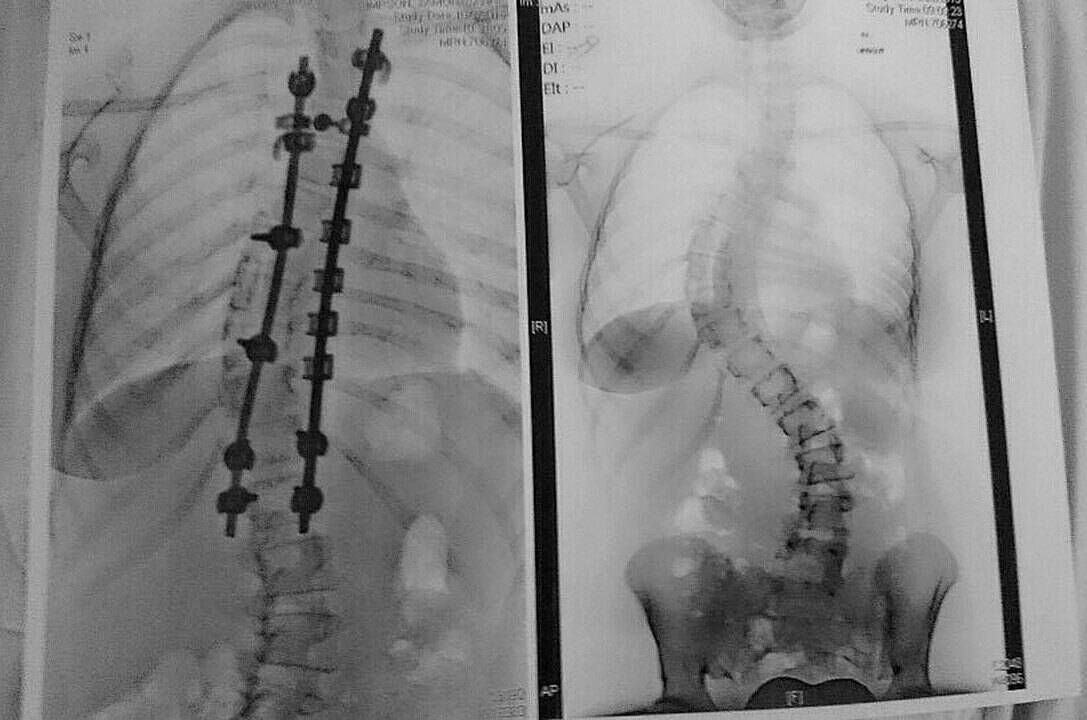Children across the country are waiting too long to see a specialist and get treatment, says a new report that highlights delays in surgery for scoliosis and the potential long-term effects on kids and the health-care system.
The report by the Conference Board of Canada says four in 10 children have surgery after six months, the clinically recommended wait time.
“Across provinces, our estimated percentage of patients receiving delayed surgical treatment beyond the recommended time frame ranges from 13 per cent in Alberta to 68 per cent in Nova Scotia,” says the report, adding comparable data across jurisdictions is limited.
Adolescent idiopathic scoliosis (AIS) is the most prevalent form of the condition, affecting about two per cent of teens. Approximately seven times more teenage girls than boys are afflicted with it, says the report released Monday.
Severe curvature of the spine can lead to a painful deformity. Surgery involves fusing the curved part of the spine with two titanium rods to prevent it from curving even further. Delays can mean kids need more complex, riskier surgery and extended stays in hospital.
The report by the independent research organization says 2,778 children in Canada are waiting for spinal surgery, but operations are often delayed by a shortage of health-care providers.
It is calling for funding to hire more pediatric surgeons, nurses and anesthesiologists. It also recommends the adoption of a pooled referral system so the first available surgeon can take on patients on a central wait list.
Emily Gruenwoldt, CEO of Children’s Healthcare Canada, which commissioned the report, said there is not enough data on the number of children waiting to be referred to a specialist before they can have surgery.
“I think there’s not great awareness of how our system is failing children and youth and the impacts of delays on their development,” Gruenwoldt said. “The current health-care system, the way it’s set up, we still expect kids to bounce back. And that’s not the case.”
Kandra West-Pettigrew of Dartmouth, N.S., said her daughter Madison had surgery for scoliosis in July 2020, a year after seeing a surgeon at age 14.
She said the eight-hour operation was emotionally draining for her and her husband, especially because pandemic restrictions meant only she could visit her daughter after surgery while her husband sat in the car outside the hospital.
West-Pettigrew said Madison had an S-shaped curvature of 65 degrees and was anxious about her appearance by the time she had surgery at Halifax’s IWK Health Centre.
“Some of her friends started to bully her because of her spinal cord issue. She went through a little bit of withdrawal,” she said.
“Otherwise she was into sports. She used to play baseball. She used to be into volleyball. Some of those incidents at school, and the related anxiety around how people were relating to her, really affected her emotionally and psychologically.”
Pediatric orthopedic surgeon Ron El-Hawary, who operated on Madison and did not speak about her case, said there are 99 children waiting for spinal surgery at IWK Health Centre.
“The majority of cases would be the adolescents with scoliosis, in which you fuse the curved part of the spine,” said El-Hawary, adding 51 children were on the wait list in 2020, when pandemic measures contributed to existing delays.
Curvature of the spine must be at 10 degrees on an X-ray for a diagnosis of AIS, and a deformity can become so severe, at about 60 or 70 degrees, that it starts to affect a child’s breathing and lung function, he said.
“The threshold for when we would recommend surgery is usually between 40 and 50 degrees because usually, scoliosis gets bigger as children grow,” El-Hawary said.
“If it’s getting to 80 degrees plus, then it’s a longer surgery. So, more complications associated with more risk of spinal cord injury, more risk of bleeding, more risk of infection. And then, of course, that’s more (operating room) time, more resources and it’s more expensive. It’s a real vicious cycle.”
El-Hawary is one of two pediatric orthopedic surgeons for all children needing spinal surgery in Nova Scotia, New Brunswick and Prince Edward Island. He said another surgeon is needed to take on the workload because some children are languishing on the wait list for up to two years.
A single-entry pooled referral system, as recommended in the report, would not work because there are not enough surgeons, he said.
“Major centres can’t do a lot of scoliosis surgery. If you think about Vancouver, Toronto, if you think about Montreal and here in Halifax, we are all facing the same issues — the long, long waiting lists.”
“I’d say the most important recommendation is that investment in the workforce.”
Dr. Stefan Parent, a pediatric orthopedic surgeon at Sainte-Justine Children’s Hospital in Montreal, said 200 kids are on the wait list there.
Those with AIS wait up to 18 months for surgery while three years is not uncommon for children with neuromuscular scoliosis, which is associated with other conditions including cerebral palsy.
Lack of operating room time due to staff shortages means he does only three surgeries a month, said Parent, adding scoliosis progresses quickly during growth spurts so those children should be treated within three months of going on a wait list.
“There are some patients that have had so much progression that we had to hospitalize them for six weeks prior to surgery, put them in traction. We place a ring around their head and then progressively add weights, up to 50 per cent of their actual weight, and stretch them prior to surgery. That just should never occur.”
READ ALSO: B.C. teen needs help to get spine surgery

